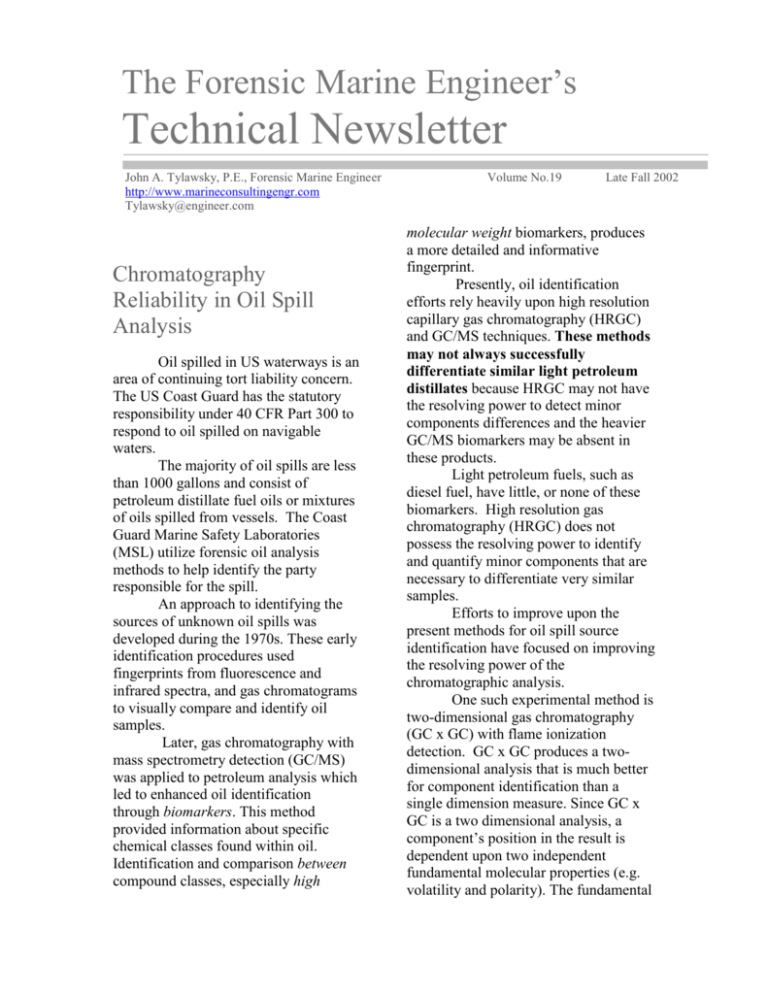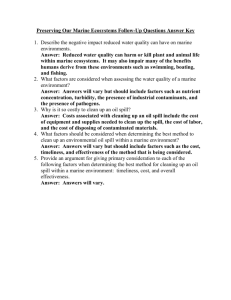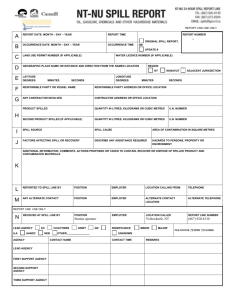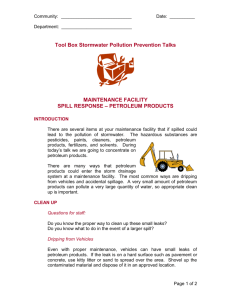Chromatography Reliability in Oil Spill Analysis
advertisement

The Forensic Marine Engineer’s Technical Newsletter John A. Tylawsky, P.E., Forensic Marine Engineer http://www.marineconsultingengr.com Tylawsky@engineer.com Chromatography Reliability in Oil Spill Analysis Oil spilled in US waterways is an area of continuing tort liability concern. The US Coast Guard has the statutory responsibility under 40 CFR Part 300 to respond to oil spilled on navigable waters. The majority of oil spills are less than 1000 gallons and consist of petroleum distillate fuel oils or mixtures of oils spilled from vessels. The Coast Guard Marine Safety Laboratories (MSL) utilize forensic oil analysis methods to help identify the party responsible for the spill. An approach to identifying the sources of unknown oil spills was developed during the 1970s. These early identification procedures used fingerprints from fluorescence and infrared spectra, and gas chromatograms to visually compare and identify oil samples. Later, gas chromatography with mass spectrometry detection (GC/MS) was applied to petroleum analysis which led to enhanced oil identification through biomarkers. This method provided information about specific chemical classes found within oil. Identification and comparison between compound classes, especially high Volume No.19 Late Fall 2002 molecular weight biomarkers, produces a more detailed and informative fingerprint. Presently, oil identification efforts rely heavily upon high resolution capillary gas chromatography (HRGC) and GC/MS techniques. These methods may not always successfully differentiate similar light petroleum distillates because HRGC may not have the resolving power to detect minor components differences and the heavier GC/MS biomarkers may be absent in these products. Light petroleum fuels, such as diesel fuel, have little, or none of these biomarkers. High resolution gas chromatography (HRGC) does not possess the resolving power to identify and quantify minor components that are necessary to differentiate very similar samples. Efforts to improve upon the present methods for oil spill source identification have focused on improving the resolving power of the chromatographic analysis. One such experimental method is two-dimensional gas chromatography (GC x GC) with flame ionization detection. GC x GC produces a twodimensional analysis that is much better for component identification than a single dimension measure. Since GC x GC is a two dimensional analysis, a component’s position in the result is dependent upon two independent fundamental molecular properties (e.g. volatility and polarity). The fundamental molecular properties needed to separate all components of a mixture are known as dimensions. Using GC x GC, compounds of similar chemical structure are grouped together in the chromatogram. In these groups, numerous small peaks representing minor components are separated and detectable. USCG FIELD EXPERIMENTS An oil spill case was selected from the US Coast Guard Marine Safety Laboratory (MSL) in Groton, CT. The anonymous case included three samples. One sample designated “Spill” contained oil emulsified in salt water. This sample was collected from the surface of the water approximately 24 h after an estimated 150-gallon spill. Two additional samples designated “Source 1” and “Source 2” were neat marine diesel samples collected from the fuel tanks of two nearby suspect vessels. The goal of oil spill case analysis was to determine the similarities and differences between the spill and possible sources. GC x GC chromatograms of the “Spill”, “Source 1”, and “Source 2” were taken. The “Spill” sample showed weathering resulting in a loss of compounds. Weathering by evaporation and dissolution occurred because the spill was on the water approximately 24 h prior to sampling. Each sample was compared to the spill qualitatively by visual comparison and quantitatively by integration of selected peaks and bands. The majority of the features in each of the oil sample chromatograms were found to be similar. The alkane range was the same in all samples. The substituted benzene, naphthalene and anthracene/phenanthrene bands appear in all samples. These macroscopic similarities result from the fact that all of the oil samples are the same oil type, specifically marine diesel fuel. However, small differences between the sample chromatograms are immediately visible. There is variation in the number and size of peaks is used to differentiate between samples. For example, “Source 2” exhibited considerably fewer peaks in the heavy aromatic region than the “Spill.” Based upon qualitative and quantitative results, “Source 1” was determined to be a probable match with the spill. These results are consistent with the conclusions of the USCG MSL, who employed HRGC and GC/MS analyses to determine the source of the spill. References: Protection of the Environment, Code of Federal Regulations, Title 40, Part 300; U.S. Government Printing Office; Washington, D.C., 1997. Bentz, A.P., Analytical Chemistry, 1979, 6, 171. Standard Method for Comparison of Waterborne Petroleum Oils by Gas Chromatography, D-3328-90; American Society for Testing and Materials: Philadelphia, 1990. Standard Practice for Oil Spill Identification by Gas Chromatography and Positive Ion Electron Impact Low Resolution Mass Spectrometry, D5739-95; American Society for Testing and Materials: Philadelphia, 1990.








